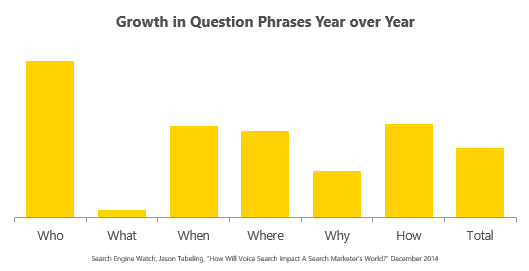With the continuous growth of mobile device usage, voice search usage has also seen steady growth. In 2014, MindMeld commissioned research in October of 1,800 adult smartphone users in the US. The company found that there has been a big uptick in voice assistant and voice search usage, with 60 percent saying that they had started using these tools in the past 12 months. Although this may not seem like a big change from traditional search, voice search is impacting SEO practices because consumers are searching differently.
No longer are consumers typing in keywords to return results. For example, with traditional text-based search, you’d type in something like “Starbucks” and you’d click on the address to find its location. With voice search, you’ll say, “Where is the nearest Starbucks?” This may seem subtle, but think about how different it really is.
Voice search is changing how we search by the use of question words: Who, what, where, why, and how. Below you can see the growth in question searches. These search questions are more natural and conversational, thus, the way marketers implement SEO needs to change as well. When voice searching, consumers are not browsing, they are searching for more specific answers, thus, long-tail keywords will begin to gain popularity.

Long-tail keywords are longer and more specific keyword phrases that visitors are more likely to use when they’re closer to a point of purchase. And, although the purchase funnel isn’t a perfect mental model, it’s useful for visualizing the search process. Below you can see how consumers are using questions in a broad interpretation of the purchasing funnel. And, as you can see, typically when consumers are using voice search, they are already familiar with the brand.

For marketers using long-tail keywords is simply establishing better lines of communication between your business and the customer who are already out there, actively shopping for what you provide. Although long-tail keywords may draw less overall traffic, the traffic that is drawn will be more focused, more committed and more desirous of the company’s service or product.
As voice search technology continues to develop and more prevalent in consumer search behavior, the guidelines will continue to change and marketers will need to adjust their strategies to accommodate. For example, common keywords are no longer successful in returning the specific content consumers are asking for. Thus, these long-tail keywords and understanding of how consumers search behavior has changed will enable the marketer to be more successful as the medium continues to grow.


Hi LaVella,
Voice search certainly requires brands to ramp up their website content efforts. To increase the odds of a brand being included in a direct answer, content must focus on answering questions. Specifically, as you pointed out, answers to questions that begin with who, what, where, why and how. If the brand’s website doesn’t directly answer those questions, it is unlikely the voice search will include the brand in a searchers’s answer. If brands are unable to determine what their target audience will ask in voice search, they will miss out on reaching that audience.
Thanks for your post!
LikeLiked by 1 person